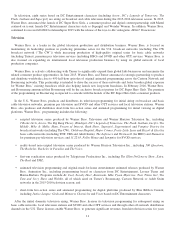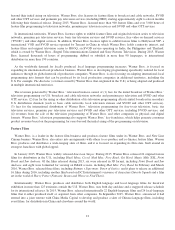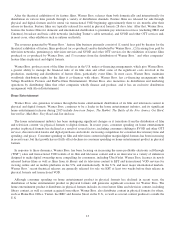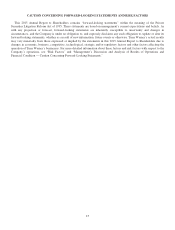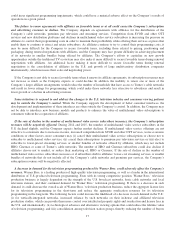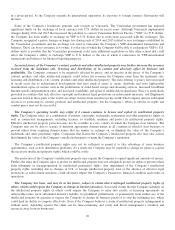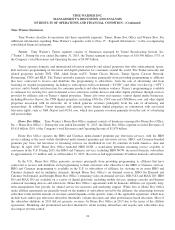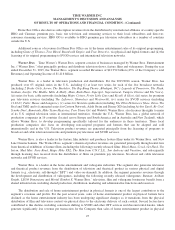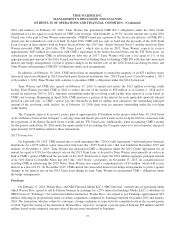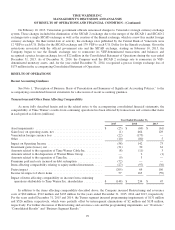Time Magazine 2015 Annual Report Download - page 34
Download and view the complete annual report
Please find page 34 of the 2015 Time Magazine annual report below. You can navigate through the pages in the report by either clicking on the pages listed below, or by using the keyword search tool below to find specific information within the annual report.in a given period. As the Company expands its international operations, its exposure to foreign currency fluctuations will
increase.
Some of the Company’s businesses generate cash receipts in Venezuela. The Venezuelan government has imposed
significant limits on the exchange of local currency into U.S. dollars in recent years. Although Venezuela implemented
changes during 2014 and 2015 that increased the potential to convert Venezuelan Bolivars Fuertes (“VEF”) to U.S. dollars,
the Company has been unable to exchange its VEF to U.S. dollars due to restrictions associated with the exchanges. The
Company recognized a pretax foreign exchange loss during each of 2014 and 2015 related to new exchanges established by
the Venezuelan government and the exchange rate used to remeasure the Company’s VEF-denominated transactions and
balances. There can be no assurance as to when, if or the rate at which the Company will be able to exchange its VEF to U.S.
dollars and it is possible that the Venezuelan government could issue additional regulations or take other actions that could
affect the Company’s ability to exchange VEF to U.S. dollars or the rate at which it remeasures its VEF-denomianted
transactions and balances for financial reporting purposes.
Increased piracy of the Company’s content, products and other intellectual property may further decrease the revenues
received from the legitimate sale, licensing and distribution of its content and adversely affect its business and
profitability. The Company continues to be negatively affected by piracy, and an increase in the piracy of the Company’s
content, products and other intellectual property could reduce the revenues the Company earns from the legitimate sale,
licensing and distribution of its content, products and other intellectual property. The risks relating to piracy have increased
in recent years due to technological developments that have made it easier to create, distribute and store high-quality
unauthorized copies of content, such as the proliferation of cloud-based storage and streaming services, increased broadband
Internet speeds and penetration rates, and increased availability and speed of mobile data transmission. Piracy is particularly
prevalent in countries that lack effective copyright and technical legal protections or enforcement measures, and illegitimate
operators based in those parts of the world can attract viewers from anywhere in the world. The Company devotes substantial
resources to protecting its content, products and intellectual property, but the Company’s efforts to enforce its rights and
combat piracy may not be successful.
The Company’s operating results may suffer if it cannot continue to license and exploit its intellectual property
rights. The Company relies on a combination of patents, copyrights, trademarks, tradenames and other proprietary rights, as
well as contractual arrangements, including licenses, to establish, maintain and protect its intellectual property rights.
Effective intellectual property protection may not be available in every country in which the Company does business. The
Company may not be able to acquire or maintain appropriate domain names in all countries in which it does business or
prevent others from acquiring domain names that are similar to, infringe on, or diminish the value of, the Company’s
trademarks and other proprietary rights. Companies that license the Company’s intellectual property also may take actions
that diminish the value of the Company’s intellectual property or harm the Company’s reputation.
The Company’s intellectual property rights may not be sufficient to permit it to take advantage of some business
opportunities, such as new distribution platforms. As a result, the Company may be required to change its plans or acquire
the necessary intellectual property rights, which could be costly.
The protection of the Company’s intellectual property may require the Company to spend significant amounts of money.
Further, the steps the Company takes to protect its intellectual property may not adequately protect its rights or prevent others
from infringing or misappropriating its intellectual proprietary rights. Any impairment of the Company’s intellectual
property rights, including due to changes in U.S. or foreign intellectual property laws or the absence of effective legal
protections or enforcement measures, could adversely impact the Company’s businesses, financial condition and results of
operations.
The Company has been, and may be in the future, subject to claims that it infringed intellectual property rights of
others, which could require the Company to change its business practices. Successful claims that the Company infringes on
the intellectual property rights of others could require the Company to enter into royalty or licensing agreements on
unfavorable terms, incur substantial monetary liability, be prohibited preliminarily or permanently from further use of the
intellectual property in question or require the Company to change its business practices to stop the infringing use, which
could limit its ability to compete effectively. Even if the Company believes a claim of intellectual property infringement is
without merit, defending against the claim can be time-consuming and costly and divert management’s attention and
resources away from its businesses.
20



